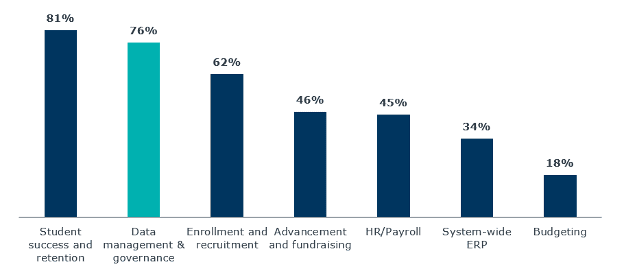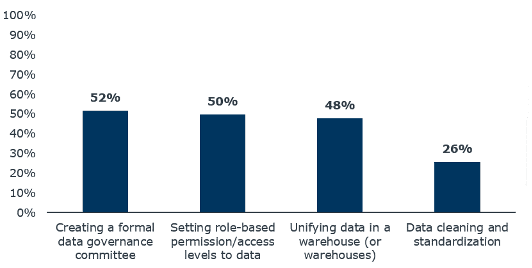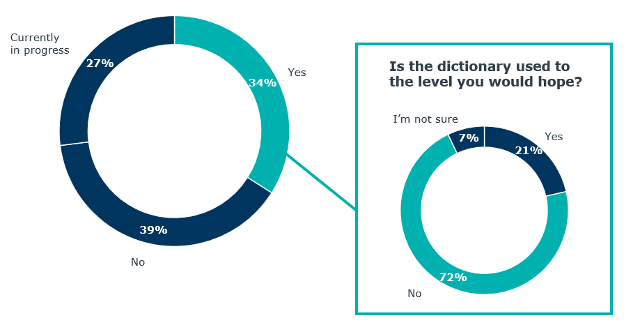3 lessons on data management from our 2023 survey of CIOs and CTOs
With the demand for data in higher education at an all-time high, technology leaders feel more pressure than ever to deliver useful data when their institutions need it. CIOs and CTOs recognize that data management and governance are essential to delivering results, but other priorities take up most of their capacity. How can leaders find the time and resources to make progress? To find out, I ran a survey in May 2023 to gather feedback from higher ed tech leaders. I polled CIOs, CTOs, and CDOs about their priorities, roadblocks, and goals.
Leading in a Complex Campus Technology Landscape
Download the insight report to review four findings from our 2023 survey of higher education technology leaders.
What I found was that—according to these leaders—today’s technology ecosystems are complex, inefficient, and expensive. The results indicate that there is plenty of progress to be made in data and technology management. But one of the hardest questions to answer is: where to begin?
In this post, I’ll share three lessons the survey taught me about data governance and management. For each point, I’ll offer relevant advice that I’ve gained from working with our partner institutions.
1. CIOs and CTOs see data management as a top priority
The survey inquired about seven institutional objectives to see where data management fit into leaders’ priorities.
In which areas of need does your institution plan to focus new technology investment in the next five years?
Respondents could select all options that apply; n=43

In an open text prompt, the survey asked respondents to share their top data priorities for the coming year. Responses included, “aligning reporting teams and data warehousing strategy,” “continued data cleanup for cross functional use,” and “identifying use cases to show the value of data management.”
Technology leaders recognize the importance of data management. But I have heard from many CIOs that other decision-makers at the institution don’t rank data management high on their priority list. Technology leaders have a responsibility to guide the conversation about data management and governance. How can you help other constituents see the same urgency you do?
Action items
Help senior leaders understand that data management contributes to progress in all other priority areas
When speaking with colleagues who don’t work directly with data in their day-to-day roles, ensure you speak their language. Explain the importance of improved data management through outcomes that matter to your audience. How can better data management equip admissions counselors to perform their work better? What data does the student success department need to reach the students who would benefit most from their help?
Leverage visible wins to showcase benefits
Data management often has tangible benefits—but not always. Consider starting with a few highly visible projects that show the value of data management. Dashboards and reports can help you build support and momentum for the more technical, opaque (but equally critical) steps.
Identify "data champions" to serve as advocates
To gain greater support for data management efforts, you may need a spokesperson with influence at the institution. A data-inclined VP, for example, can speak to the direct benefit they’ve experienced from improved data management. Assist them with a project—once they’ve seen results, they can “sell” the importance of data management to more skeptical or neutral colleagues—especially those at or above their place in the org chart.
2. Institutions are working toward data governance, but have a long way to go
The survey asked respondents to report their progress toward four critical steps in data governance. While more than half of respondents said their institution had a formal data governance committee, significantly fewer have standardized and cleansed their data.
Which of these components of data governance has your institution already implemented?
Respondents could select all options that apply; n=46

The lack of progress on data cleaning could partly be a matter of chronology. Institutions likely see “creating a committee” and “gathering data from their varied systems” as necessary steps before they standardize data. But twice the number of schools have set “role-based access permissions” to data than have cleaned and standardized it. Granting access to data that hasn’t been cleansed or standardized means running the risk of distributing untrustworthy data.
A hurdle institutions frequently run into, though, is that data cleansing and standardization is an involved, ongoing process, which is likely a contributing factor to the lower response.
Action items
Set the stage for success
If your institution has not yet formed a data governance committee, start now. Improperly governed data exposes you to significant security and privacy risks. Assemble key constituents, including leaders from the Cabinet and influenced departments across campus. A data governance committee has the influence to set goals and create policies that ensure data governance is an institutional priority.
Build governance as you go
At its outset, data governance can seem sprawling and insurmountable. But that impression is lessened when you look at governance as an ongoing effort rather than something you need to have entirely built before you can implement it. But this mentality can stall other crucial data work. Start small, experiment, and expand efforts as you find success and resolve challenges.
Automate data standardization and cleaning
Data cleaning eats up a data team’s time like nothing else. It’s a massive undertaking, and the time spent cleaning data could instead be spent fulfilling more important institutional priorities. Modern data management technology takes the work out of data cleansing and standardization, automating the process with advanced data models. Some platforms are even built specifically to work with the systems higher education already uses. Freeing time on your data team’s plate means you can take on more advanced projects that serve the institution’s biggest stakeholders.
3. Data dictionaries aren’t “set it and forget it”
Data dictionaries are a core component of data management. Dictionaries are a reference for end users to consult when viewing reports and dashboards. They create better understanding across campus, preventing misinterpretation and fostering collaboration. And importantly, they prevent questions to the IT desk about what data terms mean.
The survey results made clear that dictionaries are a priority—nearly two-thirds of schools have either created a dictionary already or have one in progress. But the results also showed that merely creating a dictionary isn’t enough to benefit from it.
Has your institution developed a data dictionary (or dictionaries)?
Respondents could select only one option; n=42

Completing work on a dictionary and distributing it to your colleagues does not guarantee anyone will actually use it. Of the survey respondents who finished data dictionaries, over two-thirds were dissatisfied with usage. More than likely, if you’ve created a dictionary or glossary for your data, you’re in the same position.
Action items
Consider the dictionary a living document
While some terms are likely to be defined the same way indefinitely, other terms change as needs and usage evolves. You will need new terms as data proliferates on campus, and duplicative or dated terms will need to be retired. Ensure you make time to review and update your data dictionary—quarterly is a good cadence to start with.
Incorporate user feedback and commentary
Create a form for collecting user input—and actually implement that input. Users are more likely to consult a resource that they know they can trust, and which they had a hand in creating.
Make the dictionary accessible and visible
Don’t expect anyone to remember the dictionary—link to it anytime you get a question about data terminology and ensure your IT desk does the same. Create 1-pagers that explain the most common terms encountered in dashboards and reports. Ensure users can search the dictionary for the exact term they’re looking for.
Start the conversation
If there’s one thing I learned from speaking to our partners, knowing where to start with data governance and management is often the hardest part. It takes dedicated, repeated conversations with senior leaders to get the support and resources you need. EAB has assisted hundreds of institutions with these conversations and efforts. Please let us know how we can help—we can connect you with an expert to discuss your institution’s unique needs.

More Blogs

Why data is a cost saver, not a cost center

AI's environmental impact can't be ignored. What can higher ed do?
